- Details
- Hits: 5576
Station: Crystal Falls, MI
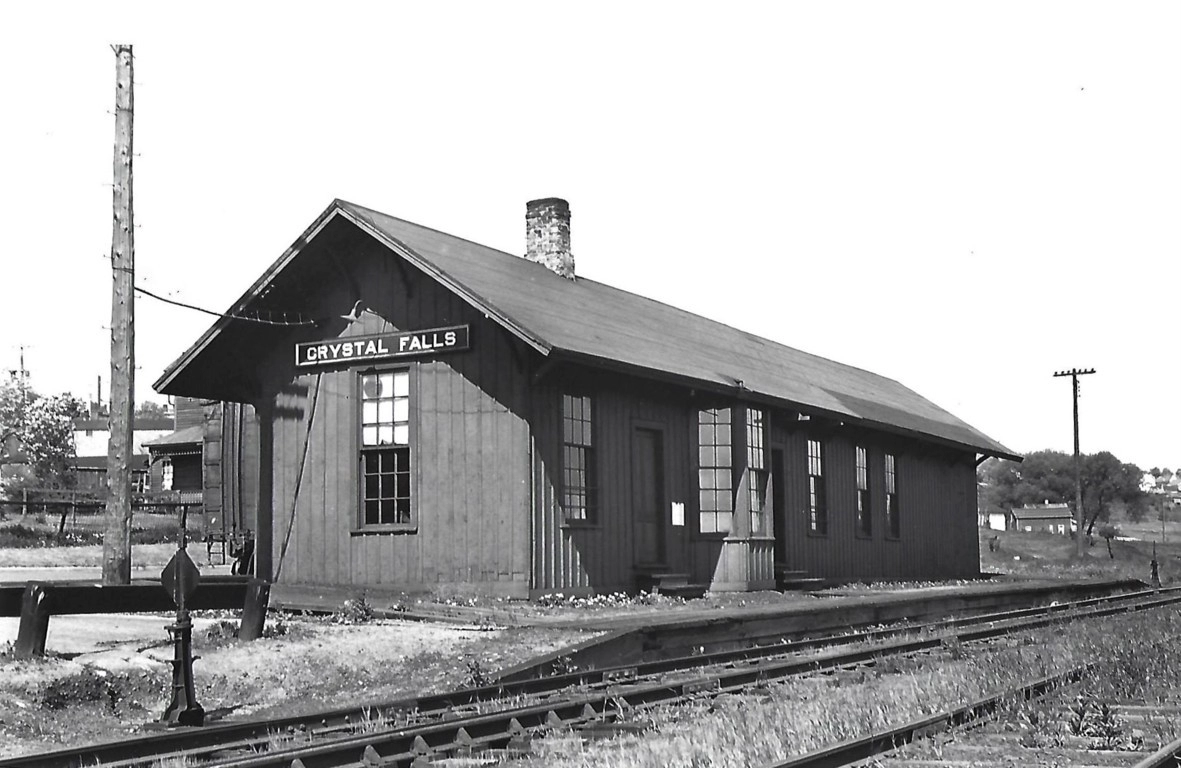
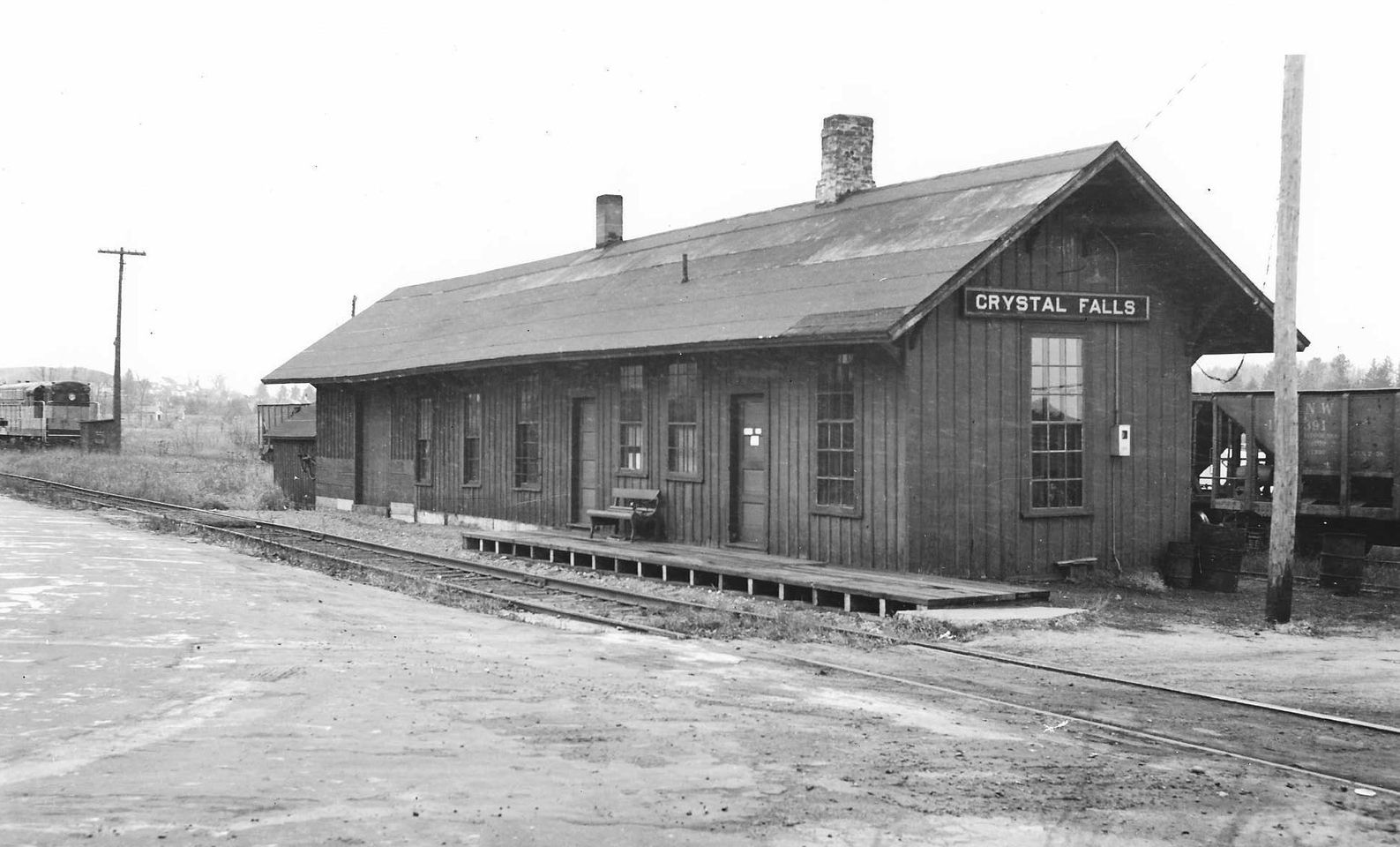
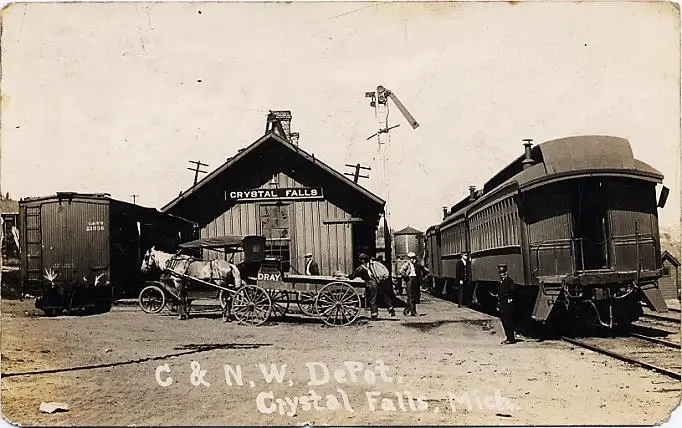
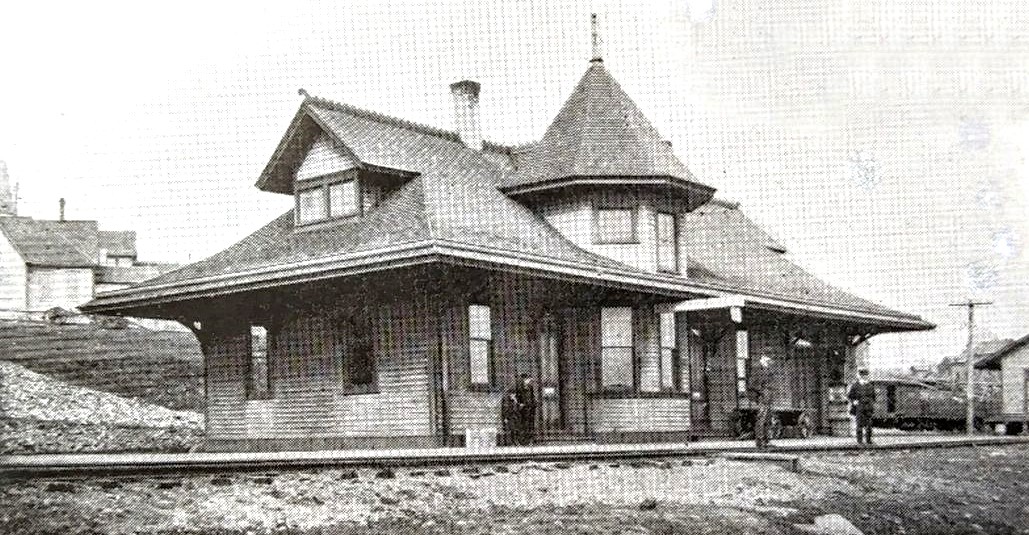

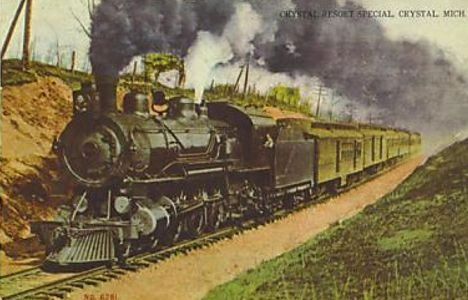
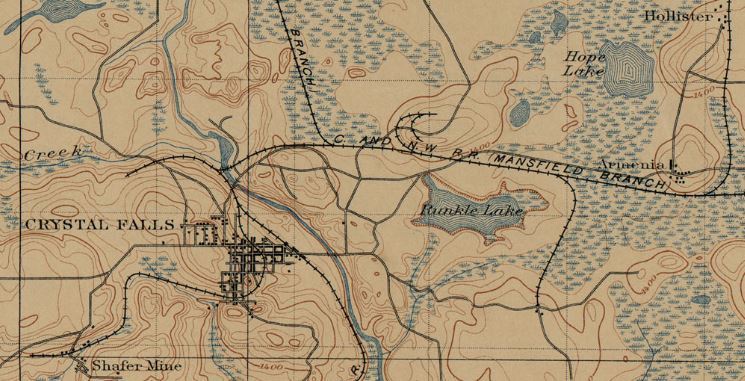
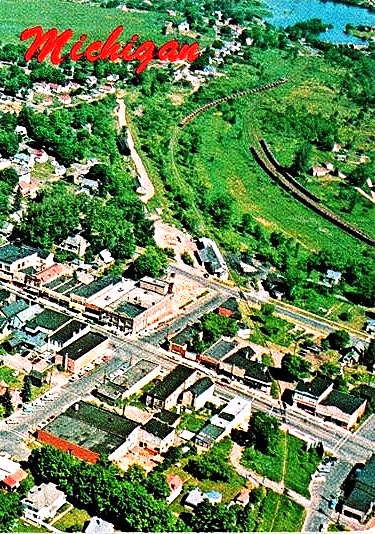 Crystal Falls was platted in 1881, but the settlement was not truly established until the arrival of the Chicago & Northwestern Railroad from Florence, Wisconsin in 1882. Florence is just south of Iron County.
Crystal Falls was platted in 1881, but the settlement was not truly established until the arrival of the Chicago & Northwestern Railroad from Florence, Wisconsin in 1882. Florence is just south of Iron County.
Mining was begun with ore being moved to Florence for shipping. By 1881, enough ore had been unearthed to warrant the extension of the C&NW from Florence, 15 miles to the south of Crystal Falls. The first train arrived in April, 1882. Mines in Crystal Falls employed more than 500 men at their peak.
The settlement was incorporated as a village in 1889 and was designated as the county seat at that time. In 1883, a strike by miners brought a temporary suspension of activities and a year later the depressed iron market forced the closing of all mines but one.
Click here for Map.
Photo Info: First and 2nd images, the Chicago & Northwestern depot at Crystal Falls. In the 2nd photo, an MILW engine appears in the distance. [Ed Selinsky photos, CNW Historical Society]. 3rd photo, the C&NW Crystal Falls Depot with a northbound 2-car passenger train. Note the train order board and water tower in the distance. 4th image, an early view of the Chicago, Milwaukee, & St. Paul depot at Crystal Falls. [Alpha Mastodon Hist. Soc.]. 5th image, a view of the Milwaukee Road Crystal Falls depot with a passenger train in front. [UML]. 6th image, a postcard view of a passenger train near Crystal Falls in 1911. The postcard suggests that this is a "Resort Special" which could have been on either the Chicago & Northwestern or the Milwaukee Road, both serving the area. [Dale Berry collection]. 7th photo is an 1895 map of Crystal Falls, prior to the Milwaukee Road coming to town. [DJB] 8th image, a partial view cropped from a postcard taken overhead of downtown Crystal Falls perhaps in the 1960's. Note the Milwaukee Road depot at Court Street, east of 3rd street. To the right of the depot is the Shafer Branch. There is a northbound ore train on the Shafer branch at the top of the photograph. To the east of the C&NW yard which has ore cars waiting to be shipped to Escanaba. The C&NW depot is south of the photograph out of sight. 9th image, a Sanborn Insurance map drawing of the C&NW turntable 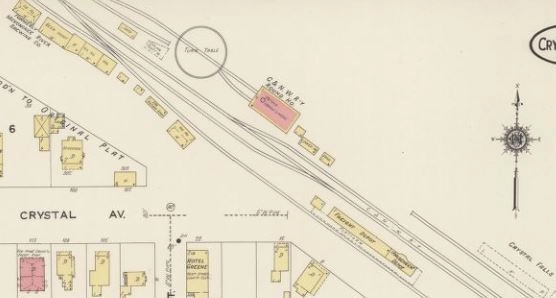 and engine house at Crystal Falls in 1922. [LOC]
and engine house at Crystal Falls in 1922. [LOC]
Notes
Lumbering provided a steady means of employment during that time. The population of Crystal Falls grew to 3,231 by the 1890 census and there were 27 saloons doing a busy trade with the clientele of miners and lumberjacks. Electric power was installed in the town in 1891 following the building of a hydroelectric power plant and water system. The village was incorporated as a city in 1899. Sewers were installed in 1902.
Growth halted in the 1930's with the arrival of the Great Depression when most of the mines were closed. The industry revived briefly during World War II, but then declined. [Iron County Historical Society information]
Why is Crystal Falls on a hill? Crystal Falls was first started by those who desired to get close to the railway. So, why was Crystal Falls located on the side hill when there are so many nice locations all about? Crystal Falls was originally located about a mile east of where it now is, and that was before the (C&NW) railroad reached here. An evidence of this is an old railroad grade near the north end of Railroad Lake where the contractor started to build the grade to reach a town located on the shores of Runkle Lake.
At the time Crystal Falls was platted, the Union Iron and Steel company was opening up the old Shafer mine and the property looked very promising. When the Union people learned of the intention of the Crystal Falls Iron Co. (the corporation which platted this city), they protested against locating a town so far from their mine. Finally they threatened to plat a rival town at the Shafer mine if Messrs. Runkle, et all persisted in locating the town on the banks of Runkle Lake.
A compromise was entered into by which the town was to be located half way between the two points but when they cast about for land the only piece that could be bought was the side-hill "forty" of the Pfister Iron Company, the piece upon which the city is now located. That is the reason why Crystal Falls is a side-hill town. [DD-1910-1001]
The railway station at Crystal Falls is 52 feet above the station at Florence, WI.
Time Line
1881. Town is platted. [Wiki].
1881. Survey of a railroad route is commenced north and west from Florence, Wisconsin. The territory is rough but the railroad will be put in as soon as the survey is complete. [DFP-1881-0415]
1881. April. It is reported that there are 19 iron properties under lease in and about Crystal Falls at the present time. [TTN-1882-0421]
1882. Chicago & Northwestern arrives (via branch line from Stager). The branch ends at Crystal Falls Junction on the north side of town.
1882. The Crystal Falls mine opens. Operates until 1913.
1882 The Great Western mine opens. Last operated in 1910 but may have shipped until 1925
1882. The Youngstown mine opens. Opens and closes and opens. Becomes the Bristol-Youngstown mine and stays open until 1969.
1882. The C&NW branch line is built from Crystal Falls Junction east over the Paint River (north of the power dam) to the Crystal Falls Mine, 1.5 miles. This is later named the Mansfield mine branch.
1882. The C&NW builds a short looping branch from Crystal Falls Junction southwest 0.4 miles to the Shafer Mine. In 1892 this is extended northwest to the Bristol Mine, and in 1911 to the Ravenna Mine for a total of 1.2 miles. This is later known as the Shafer Branch.
1882. There were seven mines in operation: The Crystal Falls; Fairbank; Great Western; Mastodon; Paint River, Shelden & Schaefer; and Youngstown.
1882. Crystal Falls is a new settlement, its principal street being a forest of pine six months ago. The lumbermen and laborers in the iron mines compose the population and the few score of frame shanties that serve as dwellings do equal duty as saloons. The locality is wild, the denizens ruthless. [DFP-1882-0930]
1883. March 28. Asa Leopold, Treasurer of the Town Board of Crystal Falls, Mich. is charged with having left town two weeks ago with $5,000 of town funds and $1,000 short on an old account, He was arrested in Chicago last night. [DFP-1883-0329] He was released the next day but immediately instituted suit in the circuit court at Chicago against George Runkel of Crystal Falls to recover $20,000 for alleged malicious prosecution. [EXP-1883-0405]
1887. May. Crystal Falls is threatened with destruction by forest fires, which are now within half a mile of town. The village has no water works or fire engine and a bucket brigade is working to save the town. Other places having steamers are afraid to let them go outside as fires are burning dangerously close. [DFP-1887-0521]
1887. The Lee Peck Mine on the Mansfield branch opens and operates until 1892.
1888. High water levels on the Paint River completely deluged the island and did considerable damage to the approach to the railroad bridge (former C&NW branch to Mansfield mine). It also damaged the nearby road bridge but the water receded before damaging the bridge at the east end of Main Street (now US-2). [DD-1888-0519]
1889. C&NW branch at Crystal Falls Mine is extended 4.7 miles to the Mansfield Mine, with a number of branch lines and spurs to various mines.
1889. C&NW builds a spur from the Mansfield branch to the Hollister Mine, 1.4 miles. In 1900 this spur is extended 0.6 miles to Lee Peck Jct. This branch was pulled up in 1914. The C&NW also builds a branch to the Armenia Mine, 1/3 mile in length, also pulled up in 1915.
1889. The Armenia Mine opens in 1889 and produced until 1914.
1889. November 28. The roundhouse of the C&NW at Crystal Falls was burned the other night and two locomotives were destroyed. [MARN-1889-1128]
1890. March. A load of one hundred cases of [blasting] powder was taken through town to the Dunn mine Wednesday. The weight of the load was 7,000 pounds. [DD-1890-0322]
1891. SNAPSHOT. At age 11, Crystal Falls boasts a High School, three Church edifices, two newspapers, two first-class hotels, two banks, a water-works supplying water for all purposes, a public electric light plant supplying streets, stores and private residences (both owned and operated by the village).
1891. A branch is built north off the Mansfield Branch (near Crystal Falls Mine) north to Amasa, 13.4 miles, to serve several mines there.
1892. The C&NW builds a 1.1 mile branch from the Mansfield branch to the Hope Mine. This branch is removed in 1903.
1892. The Bristol Mine opens and operates until 1934. Joins Youngstown mine and opens until 1969.
1893. The Panic of 1893 reduces iron ore purchases for several years in the region.
1898. Crystal Falls had a 1-bay locomotive engine house without turntable (in the same location as the 2-bay 1913 engine house (below). The railroad also had an ice house here. [SBM-1898]
1900. The Milwaukee Road (Chicago, Milwaukee, St. Paul and Pacific) builds to Crystal Falls from Channing via Kelso Jct. to a downtown depot via Crystal Falls Jct. This line also has spurs to the Crystal Falls mine (1900-1919), Great Western mine (1900-1915), Lee Peck mine (1900-1914), Carpenter Mine (1900-1945), Kimball mine (1907-1915), and the McDonald mine (1908-1913). The MILW brings competition in to the ore transport business in the Crystal Falls area.
1900. Crystal Falls population reaches 3,231 [US Census]
1901. August. The St. Paul people are making extensive improvements about their station. A fine brick walk has been laid and the bank cribbed with stone. When all the work is completed the St. Paul station will be a beauty spot that the city may well be proud of [DD-1901-0803]
1902. Judge A.L. Flewelling of Crystal Falls was a member of the mining institute party and paid his respects to The Ore people. Mr. Flewelling, besides being interested in several iron properties on the Menominee range, is general counsel for the Milwaukee & St. Paul railroad company, and his private car was one of the most elaborate in the long train. [DD-1902-0830]
1903. The Milwaukee Road crosses the Lee Peck line railroad at Crystal Falls. This is likely an industrial or mining railroad. [MCR-1904]
1907. February. Two men were coming from the mine to downtown in a cutter. The blizzard was at its height and so furiously was the snow that it was hard to distinguish the horse ahead. The passenger train was going out and evidently had to take a run to get through the snow that blocked the track. The cutter and train reached the crossing at the same moment. Someone passing along heard the train coming and yelled warning the cutter. The driver whipped up his horse and just as the cutter passed off the rails the train whirled by. No one was hurt. [DD-1907-0209]
1907. The Kimball Mine, south of town, opens and operates until 1915.
1908. The McDonald mine opens in 1908 and operates until 1913.
1909. The Milwaukee Road continues west to the Chicagon area from Crystal Falls Junction, and then to Iron River in 1914.
1910. Crystal Falls population peaks at 3,775. [US Census]
1911. An ordinance is considered to safeguard the people. Under the present arrangement, dynamite is stored on the DuPont lands south of the Kimball mine. In order to get it to the depository, it is hauled in railroad cars to a siding on the Kimball mine spur where it is unloaded and hauled in wagons to the magazine. From that point it is distributed to mines about the city. Wagons are loaded with dynamite and are hauled through the main street of the city for any mines east. [DD-1911-0311]
1911. The Ravenna mine opens, operates until 1943.
1913. The Carpenter Mine opens and operates until 1928.
1913. The number of prisoners at the Iron County jail during the year 1912 increased from 135 in the previous year to 228. The increase was due mainly to the number of bums that got to this district with the men shipped up to work on the Milwaukee Road (railroad) grade. There are five persons now in the jail charged with murder. There has been more lawlessness in Iron county during the past year and more extreme violence than for any year in its history. [TDD-1913-0104]
1913. May. There are rumors of a change in the Northwestern station site. Under the plan, the C&NW would erect a new station near the mines southwest of town, and all passenger trains to Crystal Falls would run via Mastodon. The main line would be moved to the Alpha and Shafer/Tobin branches. A commuter-style service might be run from Crystal Falls to the Dunn, Carpenter and Tobin mines. A connecting link would be built between the Dunn mine and Tobin branch east of the Tobin mine and continue to the city. Terminal facilities would be east of the Scadden residence.
The railroad is reluctant to running passenger trains through the city at the upper Superior avenue crossing (Shafer Branch near 2nd Street). One train, the Amasa passenger, is being run that way now. Two to three passenger trains are proposed. A new station would be an improvement as the C&NW station has been needing improvement for many years. [DD-1913-0513]. Note: This plan was not implemented.
1913. November. Todd Webb was "knocked out" by the crank of the big gasoline handcar at the North-Western depot Monday morning. Be was assisting to get the car started when the engine fired suddenly, throwing the big iron crank with force against his left cheek. When Todd came to, the men had him on a stretcher ready to take him to the hospital. Outside of a badly bruised cheek, he got out of the affair well. [DD-1913-1115]
1913. The top mine shippers for 1913 in the Crystal Falls area were the Bristol (379,168 tons); the Mansfield (190,503 tons); the Tobin (154,896 tons); the Armenia (831,142 tons); the Hemlock in Amasa (110,511) and the Ravenna (70,764 tons). The remaining eight mines shipped less than 50,000 tons each. [DD-1914-0321]
1914. A truce is declared in the "war" between the City of Crystal Falls and the C&NW. Railroad officials visited the city in regards to a request of the city to lay a new sewer line along the railroad right-of-way near the Columbia mine spur. The C&NW was opposed to this sewer as they "intend to build more tracks and erect buildings". The city agreed to put in more man holes along the route. It was noted that Mayor Gaffney instructed shippers of the new Seagrave fire truck and other apparatus to ship over the St. Paul road, instead of the C&NW. "The city is trying to make this a sanitary community. It expects nothing unreasonable from the North-Western railroad or anyone else. Without any good reason and with extreme discourtesy, the superintendent negatived the effort and denied half of the people of the city of sewerage.". [DD-1914-0815]
1915. The C&NW Mansfield branch is removed east of the Great Western Mine.
1916. The new switching arrangement entered into last year between the Milwaukee and the North-Western roads is in effect in the Crystal Falls District. By virtue of this arrangement the MILW switches all of the cars for the Tobin, Dunn and Carpenter mines and the C&NW all cars for the Balkan and Judson mines (near Alpha). What other mines are covered by this agreement is not disclosed as the only other property working in this district is the Bristol at which each road switches its own cars.
The C&NW empties for the Tobin, Dunn and Carpenter are pulled to the Odgers junction where they are left in the yard and a Milwaukee engine picks them up and distributes them to the respective mines. When they are loaded, the MILW engine hauls them back to the place where they were secured and there they are left for the C&NW engine.
In like manner the MILW leaves the cars intended for the Balkan or Judson mine at the Dunn mine where they are picked up by the C&NW and handled to and from the mines. By this arrangement the roads escape the duplication of switch tracks and the danger of having crews of different roads operating over the same tracks. The ore business is very heavy in the Carpenter district and the indiscriminate running back and forth of different road crews would certainly result in many collisions.
The MILW is maintaining seven engines here to handle the business and the C&NW has fully as many. The arrangement on the MILW is somewhat different than on the C&NW. On the latter road, there is a yard master and switch men, but with the MILW all employees are in the train service, the crews shooting right out for Channing as soon as their trains are made up.
Alpha ore is hauled to Mastodon by the switch engines to be picked up by road trains. [DD-1916-0429]
1917. Sheriff Wilson fooled one slacker. The fellow was a wanted man but kept in hiding until four others who were in jail had been put aboard railroad cars Monday morning. As Sheriff Wilson was returning from the train he saw the subject standing on the corner and grabbed him. He was hustled into a Ford car and ordered the driver to head for Sagola. They drove at break-neck speed and arrived at Sagola just a couple of minutes after the train pulled out, so they went on to Iron Mountain arriving there in time to turn the man over to the Deputy U.S. Marshal who was aboard with the other four. [DD-1917-0804]
1917. May. In preparation for prohibition, bars and saloons stocked up on alcohol. The North Western brought in 10 carloads of keg beer, 40½ barrels of whiskey, 71 cases of whiskey, 10 gallons of whiskey, 11 barrels of wine and 2 cases of alcohol. The Milwaukee Road brought in 2 cars of beer, 12 barrels of whiskey and 7 barrels of wine. [DD-1917-0908]
1918. MILW had a station agent here on the day shift. The C&NW had an agent during the day, and a telegraph operator on the 1st and 2nd shifts. [TRT]
1918. A box car loaded with watermelons was broken into on the St. Paul tracks last Wednesday night and a number of melons stolen. The authorities have a lineup on the boys and it is expected they will be rounded up soon. [DD-1918-0720]
1918. August 10. The Lockwood House, Crystal Falls' pioneer and only first-class hostelry, was burned almost to the ground by a fire which was discovered about 4:00 am. One life was lost and there were two severe injuries. There is no cause but speculation that defective wiring was involved.
1922. The Milwaukee Road passenger and freight depots were located north of Crystal Street between 3rd and 4th streets. This was a stub end depot, with tracks coming from the north. [SBM-1922]. This is about 2 blocks from the C&NW depot.
1937. The C&NW and Milwaukee Road create a ore pooling arrangement. From this point forward all ore is transported to the port in Escanaba. A slow process of removing duplicate mine spurs is begun.
1937. The C&NW Mansfield branch is removed from Crystal Falls Jct. to the Great Western Mine, along with the Amasa branch.
1937. The original MILW branch from Crystal Falls Jct. to Crystal Falls is removed.
1969. The MILW branch from Kelso Jct. to Crystal Falls and Iron River is abandoned and removed.
1982. C&NW Crystal Falls branch is abandoned and pulled up. [MRL] This is the last railroad service to Crystal Falls. The community's population is about 1,965.
2018. Crystal Falls population is estimated at 1,370, down from a peak of 3,775 in 1910. [Wiki]
Industry
- Crystal Falls Iron Works. Located at the foot of Superior Avenue between the railroad track and the bridge. It is owned by a Mr. Sweeney, who is also the village president (1895). [DD-1895-0302
Map
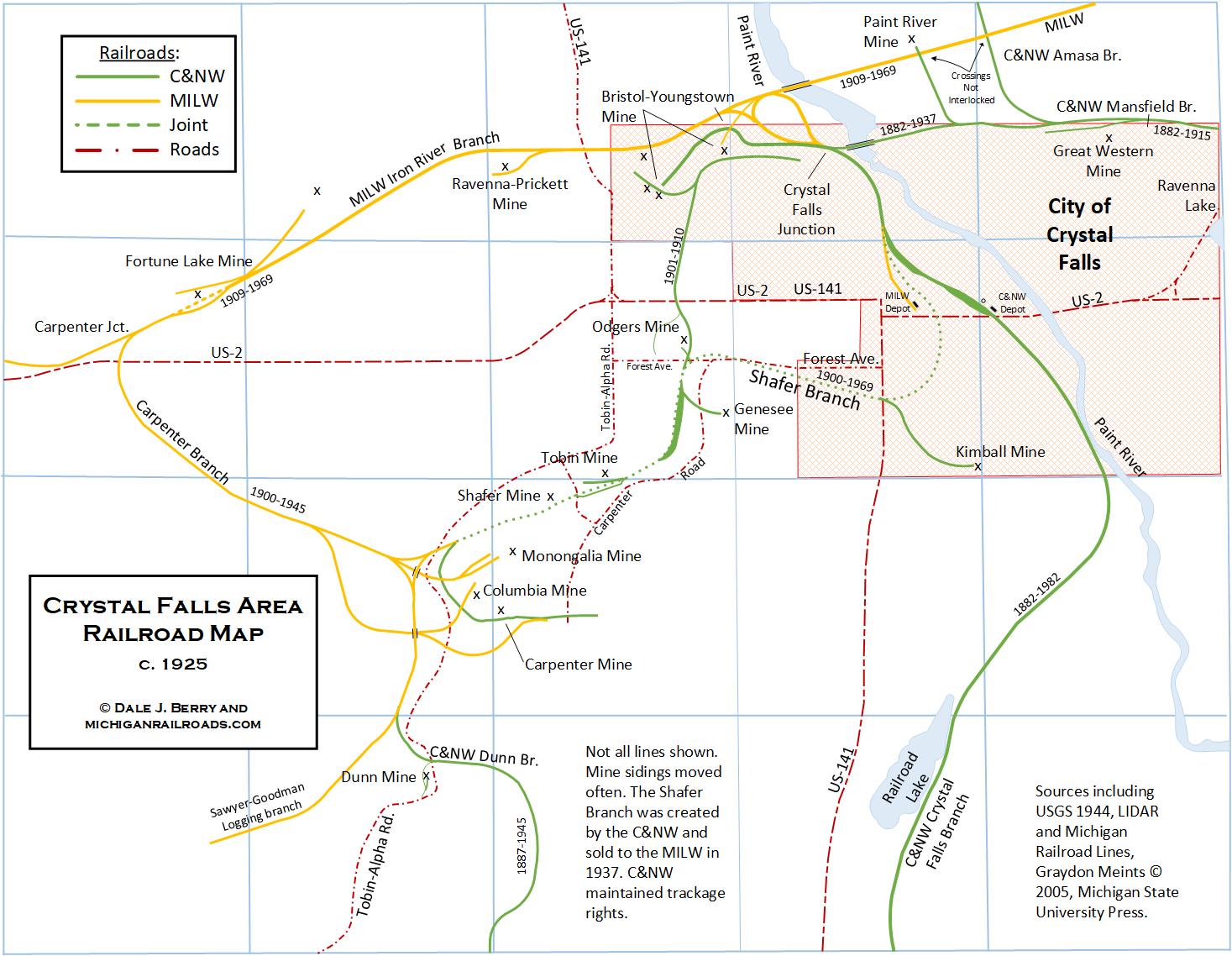
Bibliography
The following sources are utilized in this website. [SOURCE-YEAR-MMDD-PG]:
- [AAB| = All Aboard!, by Willis Dunbar, Eerdmans Publishing, Grand Rapids ©1969.
- [AAN] = Alpena Argus newspaper.
- [AARQJ] = American Association of Railroads Quiz Jr. pamphlet. © 1956
- [AATHA] = Ann Arbor Railroad Technical and Historical Association newsletter "The Double A"
- [AB] = Information provided at Michigan History Conference from Andrew Bailey, Port Huron, MI

